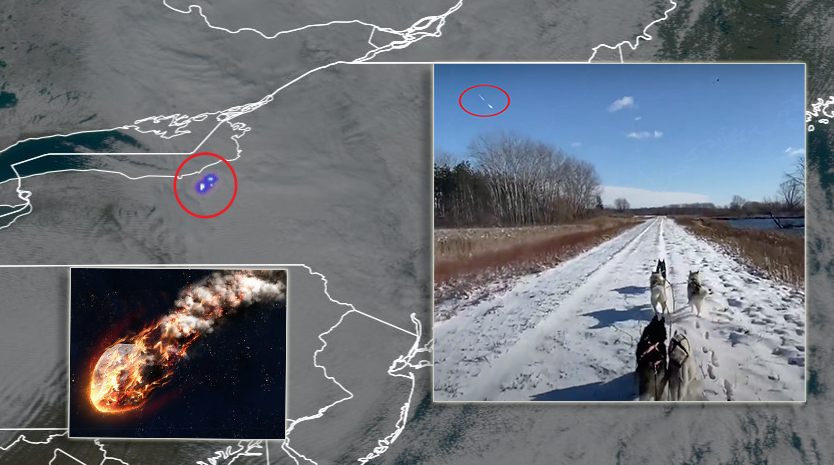Entry of Large Meteor into Atmosphere Caught on Video in Canada and Eastern U.S.
An unusually large meteor created a sensation around the upper eastern U.S. in the Great Lakes region and across southern Ontario in Canada around noon local time on Wednesday, Dec. 2, 2020. The meteor was remarkable not only for its size, but also for its proximity to populated areas, allowing its entry to be captured across the region on video and by surveillance systems.
“Holy cow, I think that was a shooting star but during the day… or a bomb!” said dog sled driver Bekka Gunner of Holland, New York, in the United States. Gunner was out training with her sled dog team from Untamed Adventure Dogs when she captured the comet’s entry on video in broad daylight. Her video was featured on Syracuse.com, a local news outlet.
Surveillance video from on top of Toronto, Ontario’s 1800-foot tall CN tower showed the brilliant flash of the fireball’s disintegration.
The meteor, also referred to as a fireball, entered the earth’s atmosphere at, “Speeds of 56,000 mph at 12:08 p.m. ET” according to the director of NASA’s Meteoroid Environment Office, Bill Cooke. Cooke went on to tell reporters that the meteor disintegrated as it entered the earth’s atmosphere at approximately 116,000 ft. or 22 miles’ altitude, somewhere between Rochester and Syracuse, New York.
By comparison, a Multiple Independent Reentry Vehicle (MIRV) warhead from an ICBM travels much slower than Wednesday’s fireball, reentering earth’s atmosphere during its terminal attack phase at approximately 15,000 mph according to the Center for Arms Control and Non-Proliferation.
“To have something so close to a major city, that’s pretty rare,” said Robert Lunsford of the American Meteor Society in a report from NBC News by Tim Stelloh.

Wednesday’s fireball was reminiscent of the massive Chelyabinsk meteor that caused widespread damage on Feb. 15, 2013, went it entered the earth’s atmosphere over southeastern Russia. The massive sonic boom and shock waves caused by the Chelyabinsk “super bolide” meteor broke glass, blew out doors and injured people from flying debris. In one case an entire factory roof collapsed from the shockwave. Because of the angle of reentry, the Chelyabinsk meteor broke into small fragments in the upper atmosphere, showering the region with shrapnel from the meteor. Interestingly, the Chelyabinsk meteor was undetected on its approach to earth’s atmosphere because its trajectory was from the sun’s direction, making detection difficult.
More recently, on August 1, 2018 at 5:14 PM Washington D.C. time a Meteor exploded with 2.1 kilotons force 43 km above missile early warning radar at Thule Air Base.
It would appear that this most recent fireball also largely disintegrated as it entered earth’s atmosphere. So far, no reports of fragments of the meteor being recovered have surfaced, suggesting either none or very few reached the ground. Any fragments that survived entry into the atmosphere may have landed in the eastern Great Lakes.









